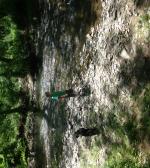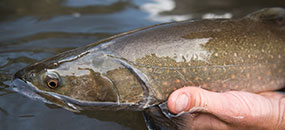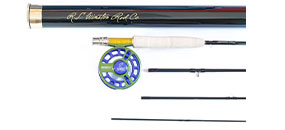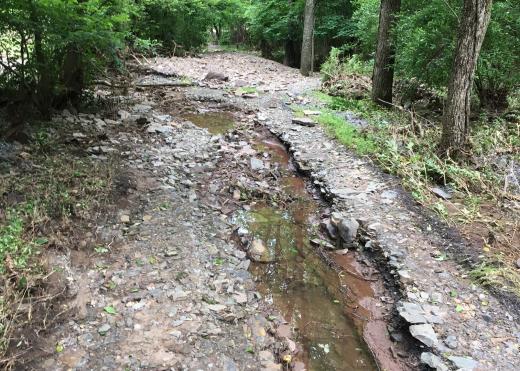By Chris Wood
Take an undersized culvert and add eight inches of rain in a few hours and you have the makings of a major problem for the creek and the adjacent road into “the holler”—the name of our place in West Virginia. A neighbor called me. “Chris, your road. It’s just gone.”
The irony wasn’t lost on me. For years, Trout Unlimited has preached the need to reconnect rivers and streams by fixing perched and undersized culverts. In 2017 alone, we reconnected nearly 750 miles of rivers and streams. As its name suggests, the holler is in a narrow hollow. The rain came overnight, and during the evening the four-foot diameter culvert plugged. The creek, with nowhere to go, rose six feet and washed over the road adjacent to, and above, the culvert. To give you a sense of its power, the flood took a 12’ by 16’ bridge I had built from old railroad ties and synthetic boards and carried it 200 yards downstream.
Any trace of the shale and gravel road into the holler was taken by the creek. Eventually, a neighbor cleaned out the culvert, and as the flood subsided, the creek filled in with material from upstream. The road was not only gone, the creek bed was now actually higher than where the road used to lie.
My first call was to Gary Berti. For more than 10 years, Gary has directed Trout Unlimited’s restoration work in West Virginia. Gary turned a small-scale restoration program into a 25 person restoration juggernaut. Few know more about stream restoration in West Virginia than Gary, and people come from all over the country to learn from our work with the Natural Resource Conservation Service, Forest Service, Fish and Wildlife Service, and the state Department of Natural Resources (DNR).
We came up with a recovery plan. First, regain access to the property. Again, any semblance of the road into the holler was gone. Second, repair the creek. Third, fix, or at least address, the source of the problem—the undersized culvert.
The first day we worked, an inch or two of rain fell in a few hours. The road became the creek. Gary said, “I am so glad I saw this. We have our work cut out for us.”
Wylie, Casey, and Henry Trace helped me to manually remove the dam caused by the bridge, and to carry the material out of the floodplain. Over the next three days, Gary and I rented and operated a skid-steer and backhoe. The kids’ outrage was real when they saw the quick work of the machines.
We checked with the DNR and learned that permits are relaxed during post flood clean-up, and that we could remove fill material from the flood from the creek. Gary determined the appropriate width-to-depth ratio for the creek, and used the backhoe to shape a few nice riffles and holes in the creek while removing fill. Replacing the culvert with a larger bottomless culvert or bridge will take some time. In the meantime, I will be getting a permit to insert some large wood jams upstream to help convince the next flood to access a ready-floodplain. That will help to diminish the downstream energy of the flood.
I was fortunate to have a stream restoration expert like Gary to help me reconstruct my stream in a way that will be ecologically sound and will leave my property less susceptible to future flood damage. Too often, landowners simply take a bulldozer or excavator and push all the material out of the streambed, leaving the stream channelized with berms on either side. Doing so not only harms aquatic ecosystems, but it also increases risk of flood damage downstream. I was reminded of a quote from Art Merrill in Trout Magazine:
“We used to have an old school mentality,” said Art, a longtime town supervisor in Colchester, N.Y. “We’d gut out our streams, try to make them flow easier, and get them away from infrastructure. We’ve learned those methods don’t hold up,” Merrill said of the old approach. “Now we know that making the streams healthier is in our best interest and helps maintain infrastructure. When we enter the stream now, we do it in the best way possible to maintain the ecology.”
The flood was a stark reminder that “freak” storms such as the one that took the bridge and road at the holler are the new normal in our part of West Virginia—just as are prolonged drought and more frequent fire in other parts of the country. It also reminded me that talking about climate change does not solve it. We need to take the restorative steps to help make both our rivers and streams and the infrastructure we depend on such as roads and culverts more resilient. At the same time, we need to collectively work toward solving the causes of our changing climate.
Not only did Gary help me, he is also helping landowners across West Virginia to improve their road-stream crossings, and to respond to floods in an ecologically smart way. For me, however, Gary’s help came at a cost, and I am looking forward to a few days of pulling barberry, Russian olive, and Stilt grass from his farm in West Virginia!
Chris Wood is the president and CEO of Trout Unlimited. He lives in Washington, D.C., but has a small farmhouse in the mountains of West Virgina.






